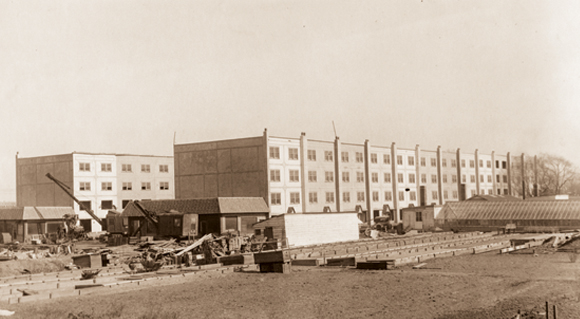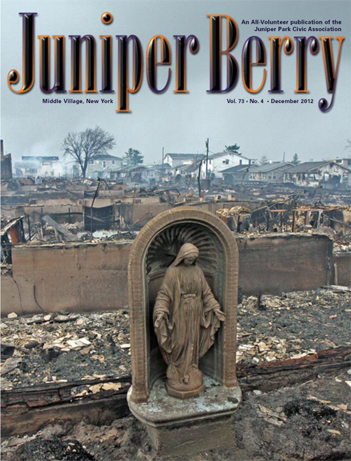New York Times October 26 1929 – Arnold Rothstein, the gambler, whose murder a year ago still remains unsolved, was presented last night by Fiorello H. La Guardia, Republican-fusion nominee for Mayor, in the new role of a real estate promoter on a large scale and the founder of a phantom village near Maspeth in Queens, located on waste and desolate swamp lands and composed of forty-eight flimsy six-family houses. These houses, he declared, were never intended for dwelling purposes, but erected solely to create the fictitious values for mulcting the city when the land should be wanted for street openings and other public purposes.
According to Mr. LaGuardia, the houses in Rothstein’s village had been “secretly surveyed” by an expert who had pronounced every structural part of the houses in violation of building ordinances, while another builder had expressed amazement that “they were standing up al all.” He said that if any plans had been filed at all, as the law requires, there could not have been the careful inspective demanded by law after construction began, the only inference being, Mr. LaGuardia said that there had been connivance by politicians and public officials in the project.
Says Sewers Were Laid
Mr. LaGuardia further advanced as evidence that the murdered gambler in his real estate venture had been closely associated with Tammany politicians and public officials, that while the land still was uninhabited and undeveloped the Board of Estimate had authorized the laying of an eight-foot sewer connecting up with the Rothstein realty holdings, which were close to a tract owned by former Borough President Maurice Connolly and other Queens politicians. According to Mr. LaGuardia, it was the fact that there had been such political investments in adjoining land, which led Rothstein to pick out this barren waste for his development. The candidate said that the gambler had first become interested in Queens’s real estate through former Borough President Joseph Cassidy, who has since died.
In his speech Mr. LaGuardia said that while Rothstein had been depicted by the police and the District Attorney as a common gambler and master of the underworld, they had purposely concealed their knowledge that he maintained close business relations with the public officials high in the councils of Tammany. As a real estate promoter, Mr. LaGuardia said, the murdered gambler was “doing business with the administration” and was closely associated in his ventures with prominent Tammany politicians and public officials.
His first real estate venture in Queens, Mr. LaGuardia stated, was taking a mortgage on property belonging to Cassidy near Maspeth. Nearby was land owned by Connolly and one of Connolly’s associates in realty promotion, Daniel Shea, former postmaster of Jamaica. The Cassidy mortgage, Mr. LaGuardia said, was held in the name of the Arnold Holding Company, which Rothstein controlled. He said it was the land holdings of Connolly and Shea that first had aroused the interest of the gambler.
Says Rothstein Had 130 Acres
“At the time of his death,” said Mr. LaGuardia, “after purchases begun in 1918, his company owned about 130 acres, forty large or eighty normal city blocks, in close proximity to the Connolly and Cassidy estate holdings.
“Rothstein and Connolly were friends. It became their common interest to book this property, which was mostly waste, desolate swampland. Improvements at public expense were considered and an eight-foot sewer projected. This is one of the famous Connolly-Phillips lockjoint sewers which caused their downfall. An eight-foot main line trunk sewer laid to waste, uninhabited land could be useful for one purpose only, and that was to provide means of draining this swampland and boosting values at public expense.”
LaGuardia said the sewer project first was broached in 1923. It was adopted by the local board of public improvements of which Benjamin Marvin, now a City Magistrate, appointed by Mayor Walker, was chairman. Mr. Marvin also was Connolly’s Superintendent of Public Works. The sewer plan was adopted, Major LaGuardia said, although not one of the petitioners was along the line of the sewer.
The official report to the Board of Estimate, LaGuardia said, was made in 1927 and attached to it was a report from the City Engineer that the sewer was “urgently needed.” After formal approval of the sewer, the Rothstein company leased the property to the Queens county Fairground Association for a racetrack, airport, amusements, etc. The lease contained the notation, according to the candidate, that after recording it the lease was to be returned to Samuel J. Burden, then an Alderman and now Democratic candidate for Sheriff of Queens, who apparently had acted as broker in the transaction. The racetrack lease was cancelled last year a month after Rothstein had been murdered.
Mr. LaGuardia said that the sewer project occurred at a time when proceedings were about to begin for the city acquiring title to nearby land for the opening of Eliot, Penelope and Eightieth Streets, all of them involving acquisition by the city of considerable Rothstein property. Owing to the political downfall of Connolly, the candidate said, there had been delay and hearings on damage claims for streets to be opened through Rothstein land have only been advertised this month.
No Offer to Rent, He Says
“A most casual inspection of these houses shows that they were never intended to be inhabited,” says the candidate. “They were never offered for rent or for sale. They are not open to inspection, but are carefully guarded against public observation. Recent secret examination by experienced and disinterested builders showed that there is nothing so extraordinary in the City of New York. Their existence is unexplainable.
“The houses show that they were simply slapped together to create a basis for a fraudulent high award in condemnation of the claims of fully developed property. They could never have been intended or used for any other purpose. This was a well thought out scheme which could have been carried out only with the connivance of high Tammany officials and which was only frustrated by the downfall of the Borough President of Queens County and the murder of Rothstein.”
Continuing, he says Tammany “cannot deny the conspiracy which resulted in the building of these forty-eight fake houses in violation of law and as part of a scheme to mulct the City of New York of huge amounts for condemnation,” and goes on: “I invite the press of the city to go out and photograph these houses and to send their architects to inspect them.”
“I call upon the District Attorney, who has denied that Rothstein had any political affiliations, to investigate further,” says Mr. LaGuardia in closing. “I call upon proper officials to ascertain why the records of Queens County are confused and folders missing. I call upon public officials to explain the existence of these forty-eight buildings in violation of law. There is more to the Rothstein case than “Who shot Rothstein?”




